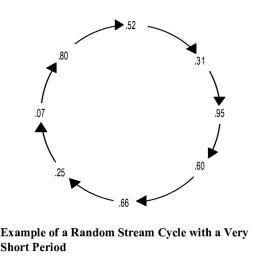
You are here: Planning the Model > Steps for Doing Simulation > Step 4: Conducting Experiments > Use of Random Streams
One of the most valuable characteristics of simulation is the ability to reproduce and randomize replications of a particular model. Simulation allows probabilistic phenomena within a system to be controlled or randomized as desired for conducting controlled experiments. This control is made available through the use of random streams.
A stream is a sequence of independently cycling, unique random numbers uniformly distributed between 0 and 1 (see the figure on next page). Random number streams are used to generate additional random numbers from other probability distributions (Normal, Beta, Gamma). After sequencing through all of the random numbers in the cycle, the cycle starts over again with the same sequence. The length of the cycle before it repeats is called the cycle period and is usually very long.

A random stream is generated using a random number generator or equation. The random number generator begins with an initial seed value after which, each successive value uses the previous value as input to the generator. Each stream used in a simulation has its own independent seed and tracks its own values for subsequent input to the generator. Where the sequence begins in the cycle depends on the initial seed value used by the generator.
Any time a particular number seeds a stream, the same sequence of values will be repeated every time the same seed is used to initialize the stream. This means that various elements within a model can be held constant with respect to their performance while other elements vary freely. Simply specify one random number stream for one set of activities and another random number stream for all other activities.
Because the same seed produces the same sequence of values every time it is used, completely independent functions within a model must have their own streams from the start. For example, arrival distributions should generally have a random number stream used nowhere else in the entire model. That way, activities added to a model that sample from a random number stream will not inadvertently alter the arrival pattern because they do not affect the sample values generated from the arrival distribution.
To show an example of how multiple streams can be useful, consider two copy machines, Copy1 and Copy2, which go down approximately every 4 hours for servicing. To model this, the frequency or time between failures is defined by a normal distribution with a mean value of 240 minutes and a standard deviation of 15 minutes, N(240,15). The time to repair is 10 minutes. If no stream is specified in the normal distribution, the same stream will be used to generate sample values for both machines. So, if the next two numbers in the stream number are .21837 and .86469, Copy1 will get a sample value from the normal distribution that is different from Copy2. Therefore, the two machines will go down at different times.
Suppose, however, that the resource servicing the machines must service them both at the same time, so we would like to have the machines go down at the same time. Using the same stream to determine both downtimes will not bring them down at the same time, because a different random number will be returned from the stream with each call to generate a random normal variate. Using two different streams, each dedicated to a machine's downtime and each having the same initial seed, will ensure that both machines go down at the same time every time. The two streams have the same starting seed value so they will produce exactly the same sequence of random numbers.